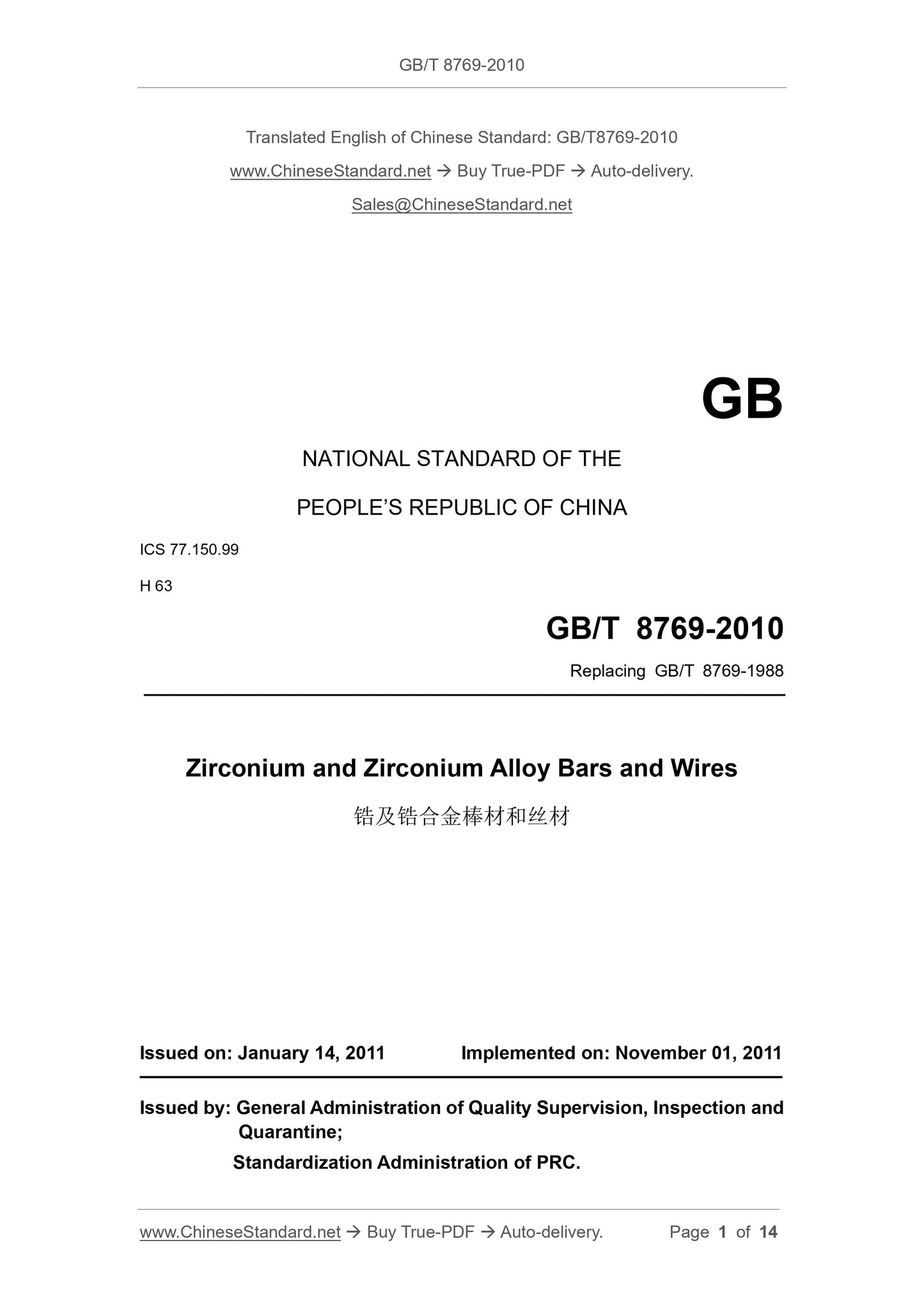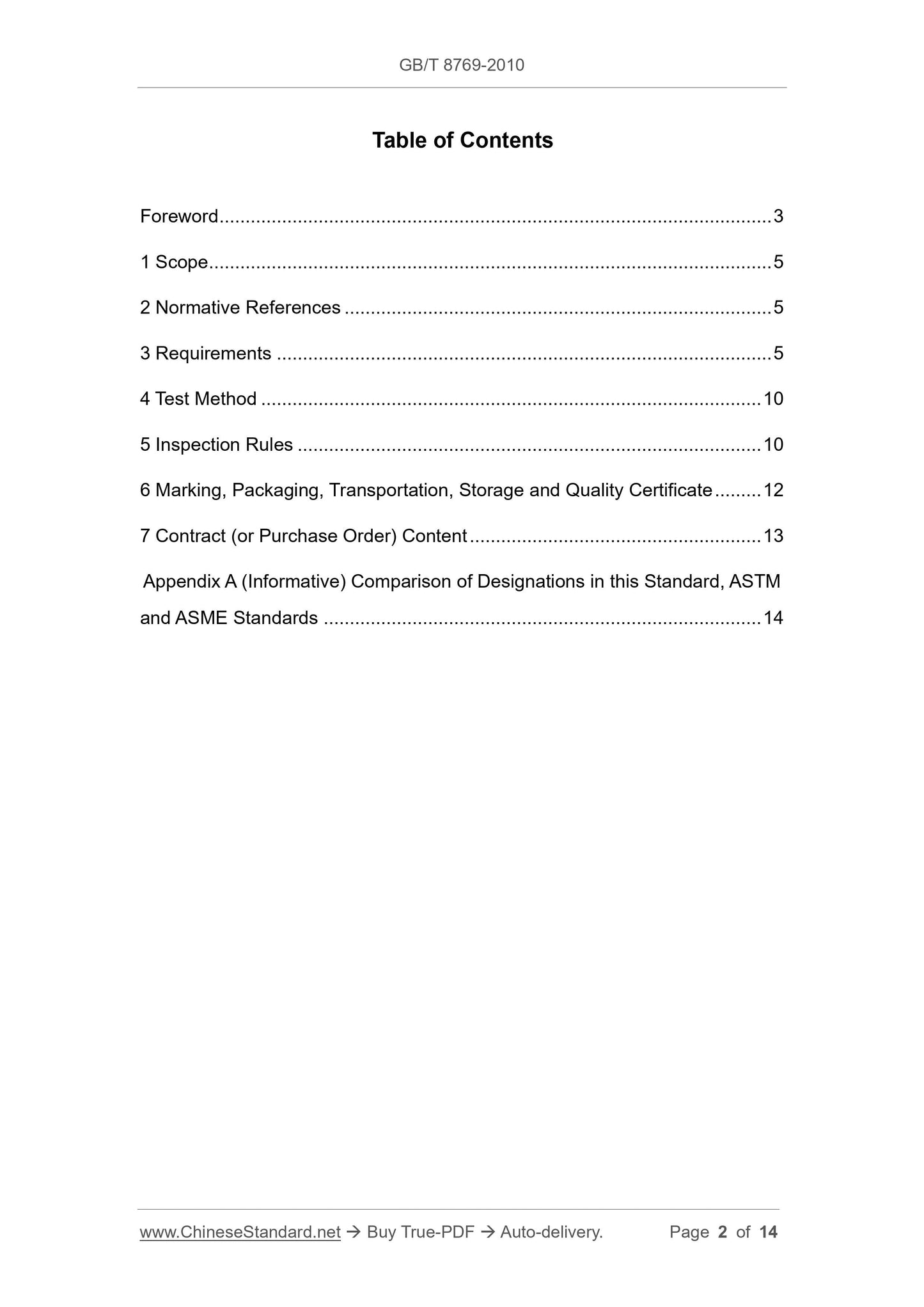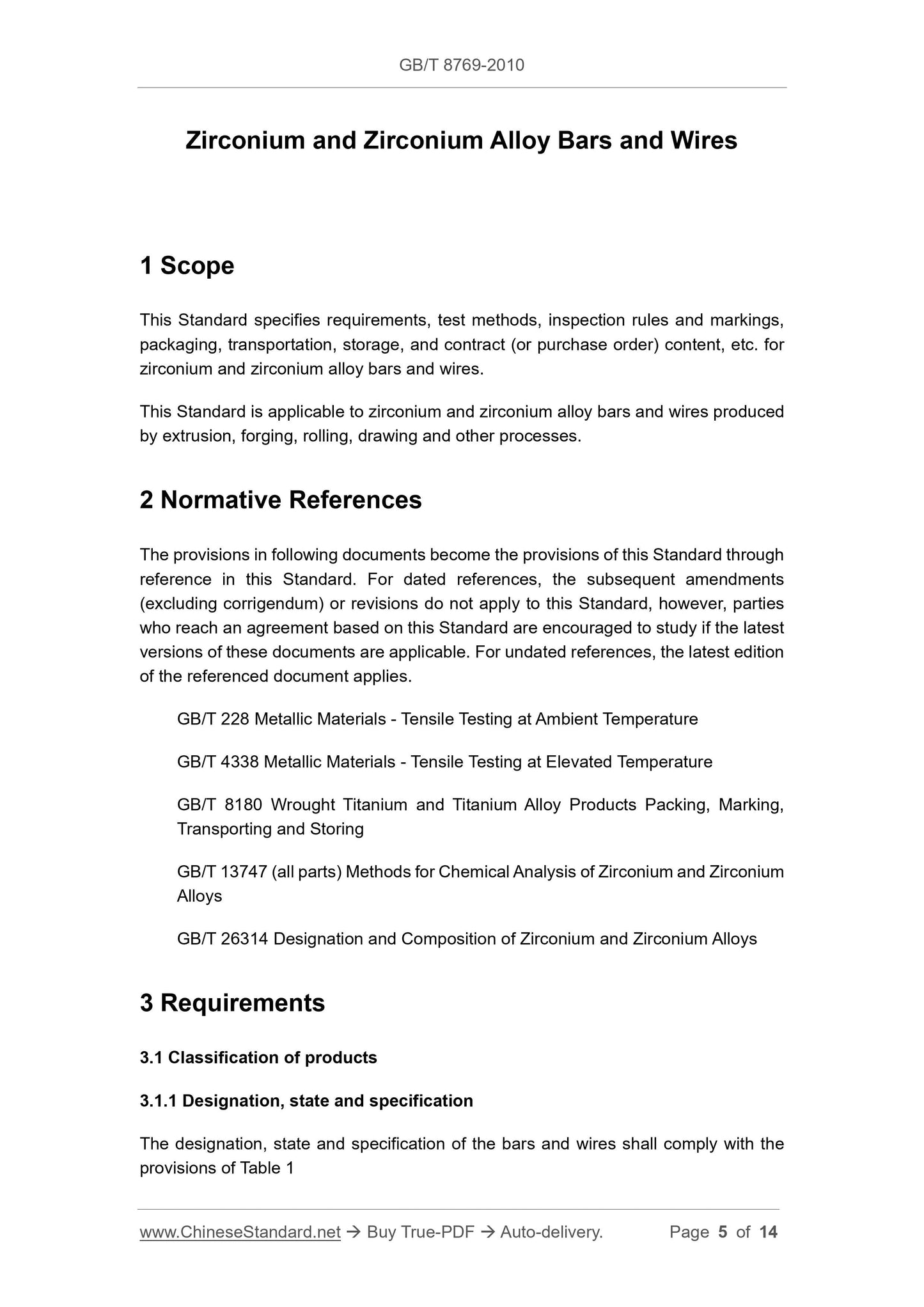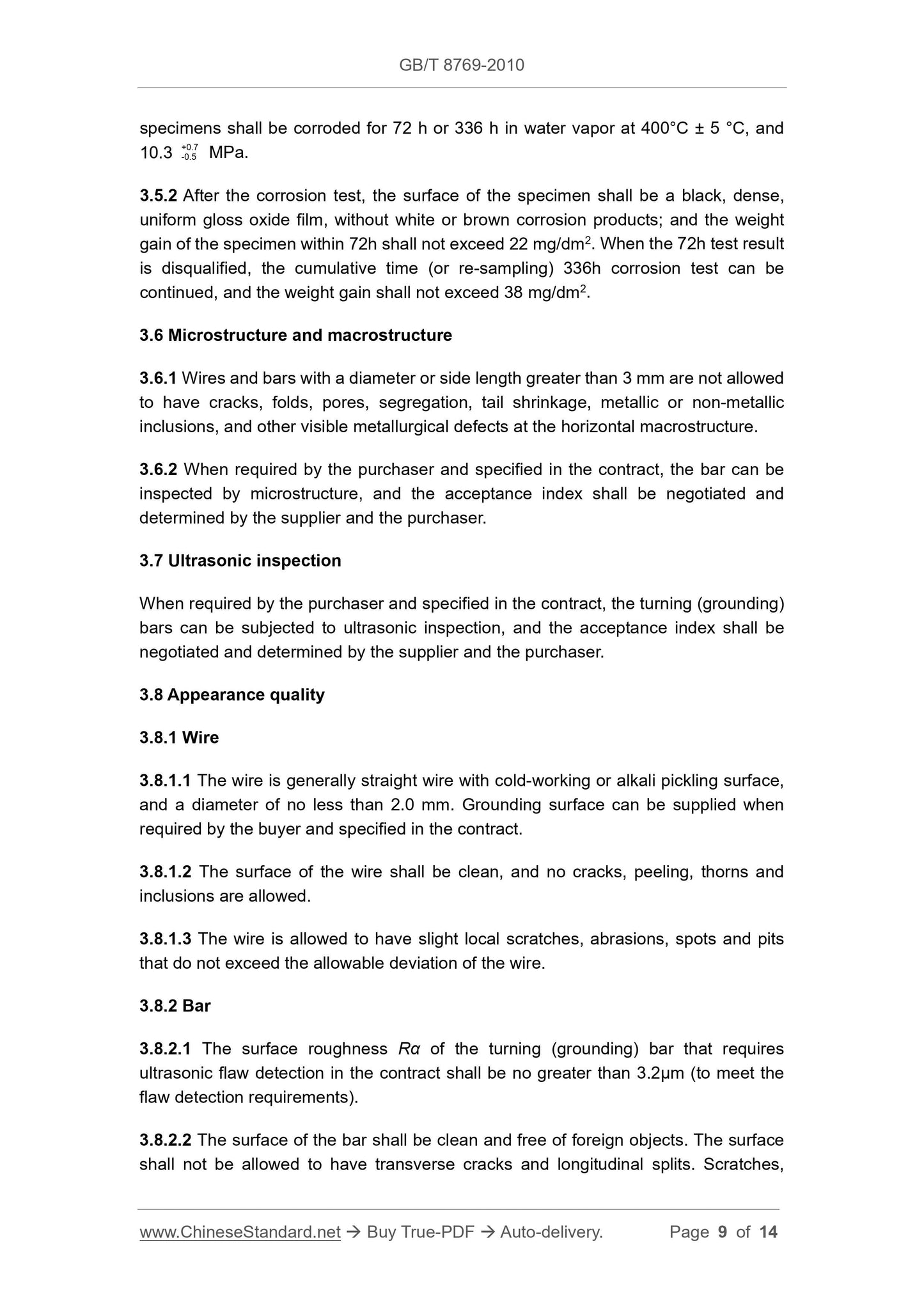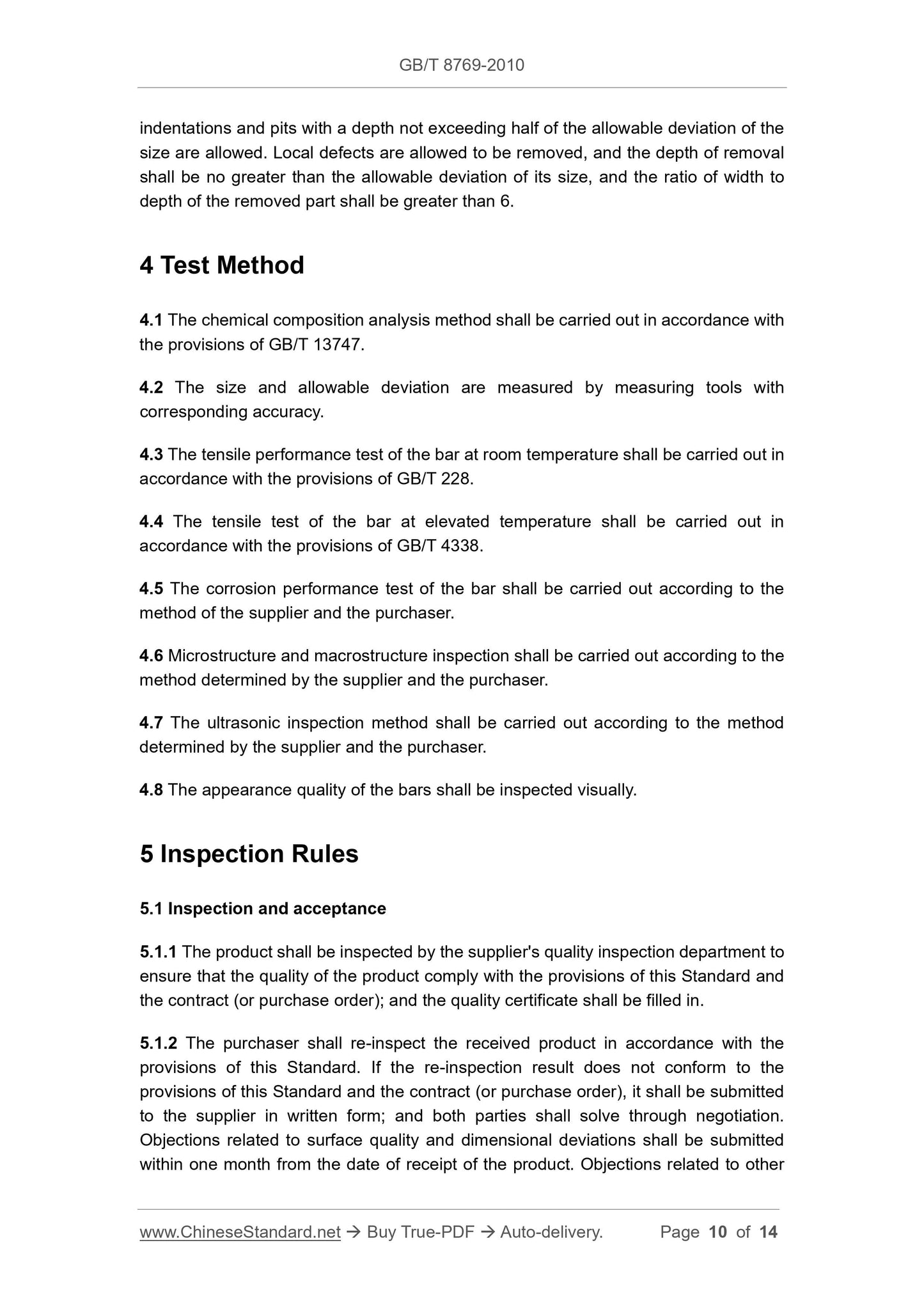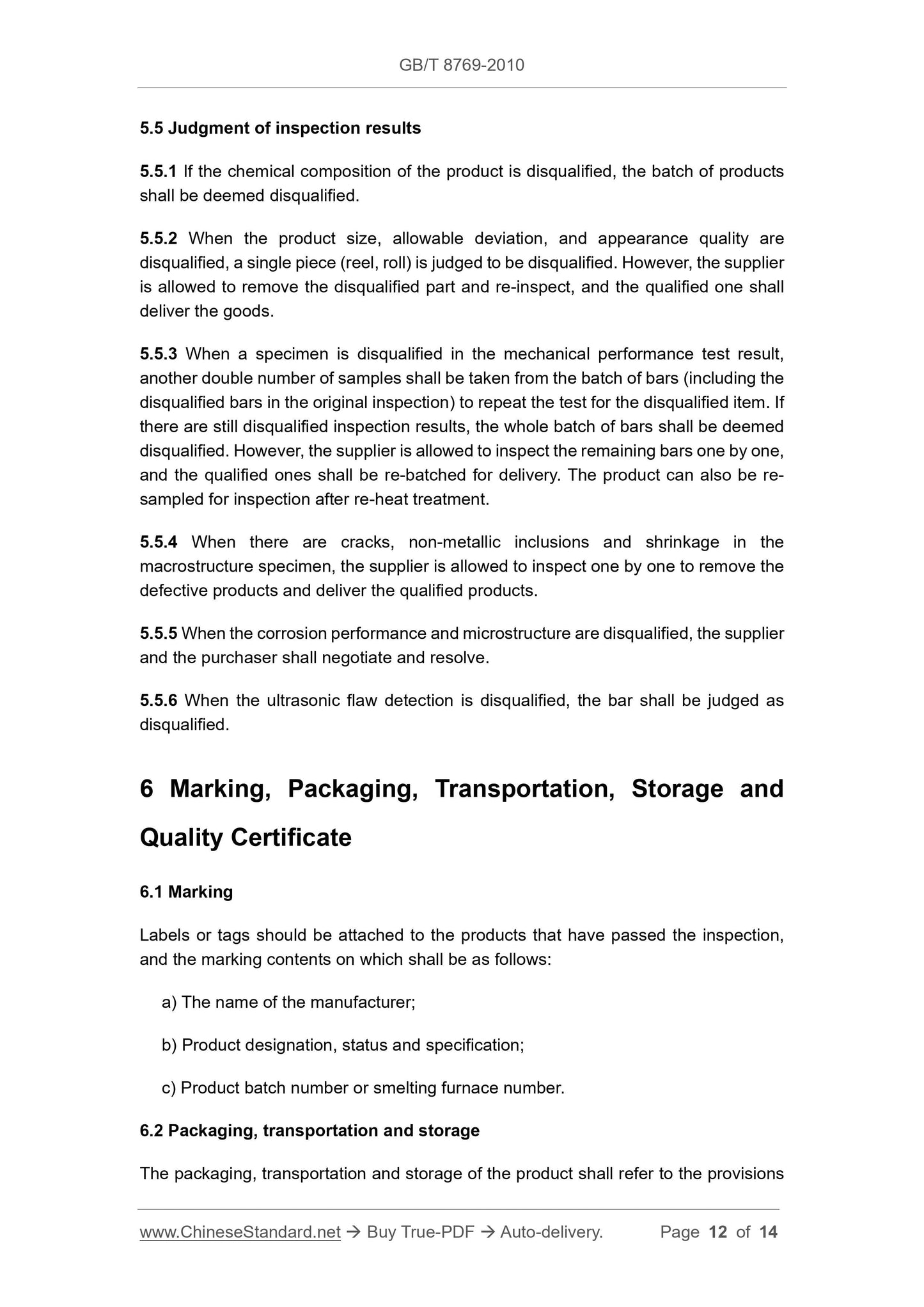1
/
of
6
PayPal, credit cards. Download editable-PDF & invoice in 1 second!
GB/T 8769-2010 English PDF (GBT8769-2010)
GB/T 8769-2010 English PDF (GBT8769-2010)
Regular price
$190.00 USD
Regular price
Sale price
$190.00 USD
Unit price
/
per
Shipping calculated at checkout.
Couldn't load pickup availability
Delivery: 3 seconds. Download true-PDF + Invoice.
Get QUOTATION in 1-minute: Click GB/T 8769-2010
Historical versions: GB/T 8769-2010
Preview True-PDF (Reload/Scroll if blank)
GB/T 8769-2010: Zirconium and zirconium alloy bars and wires
GB/T 8769-2010
GB
NATIONAL STANDARD OF THE
PEOPLE’S REPUBLIC OF CHINA
ICS 77.150.99
H 63
Replacing GB/T 8769-1988
Zirconium and Zirconium Alloy Bars and Wires
ISSUED ON: JANUARY 14, 2011
IMPLEMENTED ON: NOVEMBER 01, 2011
Issued by: General Administration of Quality Supervision, Inspection and
Quarantine;
Standardization Administration of PRC.
Table of Contents
Foreword ... 3
1 Scope ... 5
2 Normative References ... 5
3 Requirements ... 5
4 Test Method ... 10
5 Inspection Rules ... 10
6 Marking, Packaging, Transportation, Storage and Quality Certificate ... 12
7 Contract (or Purchase Order) Content ... 13
Appendix A (Informative) Comparison of Designations in this Standard, ASTM
and ASME Standards ... 14
Zirconium and Zirconium Alloy Bars and Wires
1 Scope
This Standard specifies requirements, test methods, inspection rules and markings,
packaging, transportation, storage, and contract (or purchase order) content, etc. for
zirconium and zirconium alloy bars and wires.
This Standard is applicable to zirconium and zirconium alloy bars and wires produced
by extrusion, forging, rolling, drawing and other processes.
2 Normative References
The provisions in following documents become the provisions of this Standard through
reference in this Standard. For dated references, the subsequent amendments
(excluding corrigendum) or revisions do not apply to this Standard, however, parties
who reach an agreement based on this Standard are encouraged to study if the latest
versions of these documents are applicable. For undated references, the latest edition
of the referenced document applies.
GB/T 228 Metallic Materials - Tensile Testing at Ambient Temperature
GB/T 4338 Metallic Materials - Tensile Testing at Elevated Temperature
GB/T 8180 Wrought Titanium and Titanium Alloy Products Packing, Marking,
Transporting and Storing
GB/T 13747 (all parts) Methods for Chemical Analysis of Zirconium and Zirconium
Alloys
GB/T 26314 Designation and Composition of Zirconium and Zirconium Alloys
3 Requirements
3.1 Classification of products
3.1.1 Designation, state and specification
The designation, state and specification of the bars and wires shall comply with the
provisions of Table 1
specimens shall be corroded for 72 h or 336 h in water vapor at 400°C ± 5 °C, and
10.3 +0.7 -0.5 MPa.
3.5.2 After the corrosion test, the surface of the specimen shall be a black, dense,
uniform gloss oxide film, without white or brown corrosion products; and the weight
gain of the specimen within 72h shall not exceed 22 mg/dm2. When the 72h test result
is disqualified, the cumulative time (or re-sampling) 336h corrosion test can be
continued, and the weight gain shall not exceed 38 mg/dm2.
3.6 Microstructure and macrostructure
3.6.1 Wires and bars with a diameter or side length greater than 3 mm are not allowed
to have cracks, folds, pores, segregation, tail shrinkage, metallic or non-metallic
inclusions, and other visible metallurgical defects at the horizontal macrostructure.
3.6.2 When required by the purchaser and specified in the contract, the bar can be
inspected by microstructure, and the acceptance index shall be negotiated and
determined by the supplier and the purchaser.
3.7 Ultrasonic inspection
When required by the purchaser and specified in the contract, the turning (grounding)
bars can be subjected to ultrasonic inspection, and the acceptance index shall be
negotiated and determined by the supplier and the purchaser.
3.8 Appearance quality
3.8.1 Wire
3.8.1.1 The wire is generally straight wire with cold-working or alkali pickling surface,
and a diameter of no less than 2.0 mm. Grounding surface can be supplied when
required by the buyer and specified in the contract.
3.8.1.2 The surface of the wire shall be clean, and no cracks, peeling, thorns and
inclusions are allowed.
3.8.1.3 The wire is allowed to have slight local scratches, abrasions, spots and pits
that do not exceed the allowable deviation of the wire.
3.8.2 Bar
3.8.2.1 The surface roughness Rα of the turning (grounding) bar that requires
ultrasonic flaw detection in the contract shall be no greater than 3.2μm (to meet the
flaw detection requirements).
3.8.2.2 The surface of the bar shall be clean and free of foreign objects. The surface
shall not be allowed to have transverse cracks and longitudinal splits. Scratches,
indentations and pits with a depth not exceeding half of the allowable deviation of the
size are allowed. Local defects are allowed to be removed, and the depth of removal
shall be no greater than the allowable deviation of its size, and the ratio of width to
depth of the removed part shall be greater than 6.
4 Test Method
4.1 The chemical composition analysis method shall be carried out in accordance with
the provisions of GB/T 13747.
4.2 The size and allowable deviation are measured by measuring tools with
corresponding accuracy.
4.3 The tensile performance test of the bar at room temperature shall be carried out in
accordance with the provisions of GB/T 228.
4.4 The tensile test of the bar at elevated temperature shall be carried out in
accordance with the provisions of GB/T 4338.
4.5 The corrosion performance test of the bar shall be carried out according to the
method of the supplier and the purchaser.
4.6 Microstructure and macrostructure inspection shall be carried out according to the
method determined by the supplier and the purchaser.
4.7 The ultrasonic inspection method shall be carried out according to the method
determined by the supplier and the purchaser.
4.8 The appearance quality of the bars shall be inspected visually.
5 Inspection Rules
5.1 Inspection and acceptance
5.1.1 The product shall be inspected by the supplier's quality inspection department to
ensure that the quality of the product comply with the provisions of this Standard and
the contract (or purchase order); and the quality certificate shall be filled in.
5.1.2 The purchaser shall re-inspect the received product in accordance with the
provisions of this Standard. If the re-inspection result does not conform to the
provisions of this Standard and the contract (or purchase order), it shall be submitted
to the supplier in written form; and both parties shall solve through negotiation.
Objections related to surface quality and dimensional deviations shall be submitted
within one month from the date of receipt of the product. Objections related to other
5.5 Judgment of inspection results
5.5.1 If the chemical composition of the product is disqualified, the batch of products
shall be deemed disqualified.
5.5.2 When the product size, allowable deviation, and appearance quality are
disqualified, a single piece (reel, roll) is judged to be disqualified. However, the supplier
is allowed to remove the disqualified part and re-inspect, and the qualified one shall
deliver the goods.
5.5.3 When a specimen is disqualified in the mechanical performance test result,
another double number of samples shall be taken from the batch of bars (including the
disqualified bars in the original inspection) to repeat the test for the disqualified item. If
there are still disqualified inspection results, the whole batch of bars shall be deemed
disqualified. However, the supplier is allowed to inspect the remaining bars one by one,
and the qualified ones shall be re-batched for delivery. The product can also be re-
sampled for insp...
Get QUOTATION in 1-minute: Click GB/T 8769-2010
Historical versions: GB/T 8769-2010
Preview True-PDF (Reload/Scroll if blank)
GB/T 8769-2010: Zirconium and zirconium alloy bars and wires
GB/T 8769-2010
GB
NATIONAL STANDARD OF THE
PEOPLE’S REPUBLIC OF CHINA
ICS 77.150.99
H 63
Replacing GB/T 8769-1988
Zirconium and Zirconium Alloy Bars and Wires
ISSUED ON: JANUARY 14, 2011
IMPLEMENTED ON: NOVEMBER 01, 2011
Issued by: General Administration of Quality Supervision, Inspection and
Quarantine;
Standardization Administration of PRC.
Table of Contents
Foreword ... 3
1 Scope ... 5
2 Normative References ... 5
3 Requirements ... 5
4 Test Method ... 10
5 Inspection Rules ... 10
6 Marking, Packaging, Transportation, Storage and Quality Certificate ... 12
7 Contract (or Purchase Order) Content ... 13
Appendix A (Informative) Comparison of Designations in this Standard, ASTM
and ASME Standards ... 14
Zirconium and Zirconium Alloy Bars and Wires
1 Scope
This Standard specifies requirements, test methods, inspection rules and markings,
packaging, transportation, storage, and contract (or purchase order) content, etc. for
zirconium and zirconium alloy bars and wires.
This Standard is applicable to zirconium and zirconium alloy bars and wires produced
by extrusion, forging, rolling, drawing and other processes.
2 Normative References
The provisions in following documents become the provisions of this Standard through
reference in this Standard. For dated references, the subsequent amendments
(excluding corrigendum) or revisions do not apply to this Standard, however, parties
who reach an agreement based on this Standard are encouraged to study if the latest
versions of these documents are applicable. For undated references, the latest edition
of the referenced document applies.
GB/T 228 Metallic Materials - Tensile Testing at Ambient Temperature
GB/T 4338 Metallic Materials - Tensile Testing at Elevated Temperature
GB/T 8180 Wrought Titanium and Titanium Alloy Products Packing, Marking,
Transporting and Storing
GB/T 13747 (all parts) Methods for Chemical Analysis of Zirconium and Zirconium
Alloys
GB/T 26314 Designation and Composition of Zirconium and Zirconium Alloys
3 Requirements
3.1 Classification of products
3.1.1 Designation, state and specification
The designation, state and specification of the bars and wires shall comply with the
provisions of Table 1
specimens shall be corroded for 72 h or 336 h in water vapor at 400°C ± 5 °C, and
10.3 +0.7 -0.5 MPa.
3.5.2 After the corrosion test, the surface of the specimen shall be a black, dense,
uniform gloss oxide film, without white or brown corrosion products; and the weight
gain of the specimen within 72h shall not exceed 22 mg/dm2. When the 72h test result
is disqualified, the cumulative time (or re-sampling) 336h corrosion test can be
continued, and the weight gain shall not exceed 38 mg/dm2.
3.6 Microstructure and macrostructure
3.6.1 Wires and bars with a diameter or side length greater than 3 mm are not allowed
to have cracks, folds, pores, segregation, tail shrinkage, metallic or non-metallic
inclusions, and other visible metallurgical defects at the horizontal macrostructure.
3.6.2 When required by the purchaser and specified in the contract, the bar can be
inspected by microstructure, and the acceptance index shall be negotiated and
determined by the supplier and the purchaser.
3.7 Ultrasonic inspection
When required by the purchaser and specified in the contract, the turning (grounding)
bars can be subjected to ultrasonic inspection, and the acceptance index shall be
negotiated and determined by the supplier and the purchaser.
3.8 Appearance quality
3.8.1 Wire
3.8.1.1 The wire is generally straight wire with cold-working or alkali pickling surface,
and a diameter of no less than 2.0 mm. Grounding surface can be supplied when
required by the buyer and specified in the contract.
3.8.1.2 The surface of the wire shall be clean, and no cracks, peeling, thorns and
inclusions are allowed.
3.8.1.3 The wire is allowed to have slight local scratches, abrasions, spots and pits
that do not exceed the allowable deviation of the wire.
3.8.2 Bar
3.8.2.1 The surface roughness Rα of the turning (grounding) bar that requires
ultrasonic flaw detection in the contract shall be no greater than 3.2μm (to meet the
flaw detection requirements).
3.8.2.2 The surface of the bar shall be clean and free of foreign objects. The surface
shall not be allowed to have transverse cracks and longitudinal splits. Scratches,
indentations and pits with a depth not exceeding half of the allowable deviation of the
size are allowed. Local defects are allowed to be removed, and the depth of removal
shall be no greater than the allowable deviation of its size, and the ratio of width to
depth of the removed part shall be greater than 6.
4 Test Method
4.1 The chemical composition analysis method shall be carried out in accordance with
the provisions of GB/T 13747.
4.2 The size and allowable deviation are measured by measuring tools with
corresponding accuracy.
4.3 The tensile performance test of the bar at room temperature shall be carried out in
accordance with the provisions of GB/T 228.
4.4 The tensile test of the bar at elevated temperature shall be carried out in
accordance with the provisions of GB/T 4338.
4.5 The corrosion performance test of the bar shall be carried out according to the
method of the supplier and the purchaser.
4.6 Microstructure and macrostructure inspection shall be carried out according to the
method determined by the supplier and the purchaser.
4.7 The ultrasonic inspection method shall be carried out according to the method
determined by the supplier and the purchaser.
4.8 The appearance quality of the bars shall be inspected visually.
5 Inspection Rules
5.1 Inspection and acceptance
5.1.1 The product shall be inspected by the supplier's quality inspection department to
ensure that the quality of the product comply with the provisions of this Standard and
the contract (or purchase order); and the quality certificate shall be filled in.
5.1.2 The purchaser shall re-inspect the received product in accordance with the
provisions of this Standard. If the re-inspection result does not conform to the
provisions of this Standard and the contract (or purchase order), it shall be submitted
to the supplier in written form; and both parties shall solve through negotiation.
Objections related to surface quality and dimensional deviations shall be submitted
within one month from the date of receipt of the product. Objections related to other
5.5 Judgment of inspection results
5.5.1 If the chemical composition of the product is disqualified, the batch of products
shall be deemed disqualified.
5.5.2 When the product size, allowable deviation, and appearance quality are
disqualified, a single piece (reel, roll) is judged to be disqualified. However, the supplier
is allowed to remove the disqualified part and re-inspect, and the qualified one shall
deliver the goods.
5.5.3 When a specimen is disqualified in the mechanical performance test result,
another double number of samples shall be taken from the batch of bars (including the
disqualified bars in the original inspection) to repeat the test for the disqualified item. If
there are still disqualified inspection results, the whole batch of bars shall be deemed
disqualified. However, the supplier is allowed to inspect the remaining bars one by one,
and the qualified ones shall be re-batched for delivery. The product can also be re-
sampled for insp...
Share
